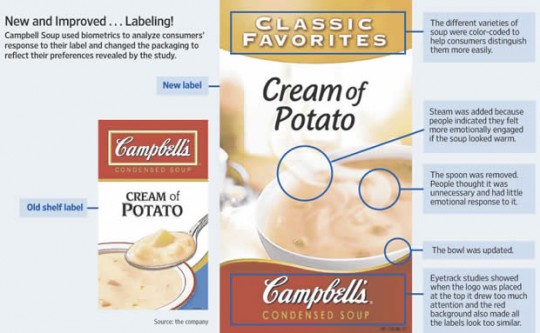Neuromarketing: From Soup to Nuts
I’ve been chronicling the nascent neuromarketing industry since 2006, and I don’t think I’ve seen a story to date which captured social media attention to the degree that the recent Campbell Soup neuromarketing story did. The original story in the Wall Street Journal fueled a mini-boom of Twitter and blogging activity. Why? I think the fact that a major consumer products company went on the record about their use of neuromarketing, and even provided specifics of how they changed their marketing, was the driving force. This was an unusually detailed look inside a practical application of neuromarketing.
I thought it might be worthwhile to highlight some of the discussion of the Campbell story:
The Emotional Quotient of Soup Shopping – the original WSJ story by Ilan Brat.
Campbell’s Soup Neuromarketing Redux: There’s Chunks of Real Science in That Recipe – one of the most recent analyses, this is a particularly good piece of reporting by Jennifer Williams. She details some of the different techniques used by Campbell, including a deep interview process called ZMET (The Zaltman Metaphor Elicitation Technique). She also points out the role of Merchant Mechanics. They were “brought in at the end of 18 months to relate actual in-store consumer behavior to Innerscope’s biometrics and to the findings of the deep interviews. Tullman’s team used a combination of proprietary micro facial expression analysis obtained by in-store cameras, in-aisle eye tracking and pupilometry, and intercept interviews.”
New Packaging for Campbell’s Soup Impacts User Experience & Hopefully Sales – Fresh ID’s design and user experience expert Kristi Colvin addresses the new labels along with the “evil marketer” issue.
Your Brain on Soup – my own first take on the soup story.
Campbell Soup Labels and Neuromarketing – The Eponymous Pickle
Campbell Soup’s Labels Redesigned Using Neuromarketing – PSFK
Using Neuromarketing, Campbell learned what to change on its soup labels to make sales “Mmm mm good.” – Dave Ibsen
Neuromarketing: Have You Tried It? – Kiwi Communications Blog
Food label designed by “neurological and bodily responses” – BoingBoing
Campbell’s new label ingredient: biometrics – Helen Klein Ross, aka The Ad Broad
Campbells Goes Deep for Soup – Participatory Advertising
Campbell to Retire Iconic Soup Labels in Favor of “Neuromarketing” – Hit the Buzzer
Focus Groups Suck! – An Interpretivist’s Clog
M’m, m’m good – In Good Taste
Waiter, There’s Pseudo-Science in My Soup – FastCompany’s William Bostwick attacks the idea of Campbell’s approach with precious little in the way of factual critique. Didn’t quite make the “nuts” category.
And, since the title promises nuts… some people are totally freaked out by the idea of neuro-soup-labels:
Campbell Soup’s Neuromarketing – Disinformation, who “won’t be buying any Campbell’s soup for a while, that’s for sure.”
Big Soup – The Red Lion Reports blog hopes that “at least some of the testers faced up to the shelves while hooked up to the electronics and got amorous thoughts about past lovers.”
Neuromarketing: Campbell’s Soup & ?? – SoulVeggie didn’t seem to mind the neuromarketing study as much as the soup itself, calling the products “appalling and disgusting… laboratory processed swill.” No “mmm, mmm good” there…
Surprisingly, the story didn’t bring out the neuro-alarmists in any great numbers. Maybe they believe a neuro-optimized TV commercial is more likely to turn you into a product-buying zombie than a can of soup.
This is just a sampling of the outpouring of the web commentary on the Campbell’s redesign – if your blog has an original take on the topic, or if I missed a good one from someone else, feel free to post a link in the comments.


Great round up! I’m honored that you called my piece, “a particularly good piece of reporting”. There was so much more detail that I couldn’t squeeze in, but maybe I’ll follow up in a blog post.
Hi Roger,
I know this topic is already 2 years old but I have been studying the case and I have a question. Actually two questions and I am wondering whether you (or anybody else reading this?) could help.
First, every article mentioned above is using the word neuromarketing but in fact they did not use any of “hard” neuromarketing techniques, did they? They “only” studied the secondary biometrics if I am not wrong? (and I beg your pardon if I am using improper vocabulary) So how can this be represented as one of the most famous usage of neuromarketing?
Second question concerns the results. As it is 2 years old case, I would expect some results about their sales, which they wanted to boost by this action in the first place. Nevertheless, I could not find any. Do you maybe have more info about it?
Thank you very much and thanks for writing your blog, I am your (almost regular) reader! 🙂
Best regards,
Kamila
I guess it depends on how you define the area, Kamila. My neuromarketing definition is broad enough to include behavioral reasearch, based on the logic that consumer behavior is what we are trying to understand, and the tools we use simply show different views of what’s going on. Not everyone agrees with that, of course, and there’s a move to label brain wave/brain scan studies as “consumer neuroscience.”
I agree it would be interesting to see a post-mortem on the effects of the new label designs, though it would likely be highly subjective unless Campbell’s did some kind of A/B testing in selected markets. Another factor is that the neuromarketing studies were just one part of the market research process leading to the new label design, which could further muddy the water.
How would you define neuromarketing, Kamila?
Roger